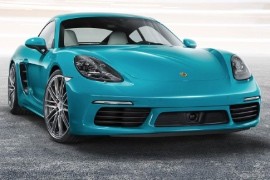PORSCHE 718 Cayman S Models/Series Timeline, Specifications & Photos
First production year: 2016
Engines: Gasoline
Body style: Coupé (two-door)
Porsche introduced the 718 Cayman, which had the 782C factory code in 2016, and it was a revolution in the model's history due to its fresh, four-cylinder turbocharged engine.
For the brand's fans, the 718 moniker was significant. It was the nameplate used by the Porsche that won the Targa Florio race in 1959 and 1960. Then, the automaker created another race car bearing the same number and won the top two places of the dramatic 1970 24 Hours of LeMans competition when just seven vehicles completed the race, while the podium was completed by another Porsche, a 908. As a result, the automaker had to be very careful when it applied that glorious nameplate to the Boxster/Cayman lineup that it launched in 2016. For that, it took what worked best on the previous generation of these vehicles, which had the 981 and 981C factory codes, respectively, and added some new or enhanced parts to create a fresh car. While it still relied on the same chassis as before, the new model had almost any body panel replaced. In addition, the suspension system was carried over from the 911 for the front axle and adjusted for the rear one. Unlike the Boxster, which was a roadster, the Cayman was a proper four-season sports car bearing Porsche's DNA.
At the front, the automaker introduced new headlights that featured bi-xenon technology and integrated four LED blocks for the daytime running lights. These were fitted as standard, while customers could upgrade them to all-LEDs as an option. Lower, on the side scoops, the automaker included slim blinkers and additional DRLs. These flanked a trapezoidal-shaped center air intake needed for additional cooling. It is worth mentioning that all these vents were functional.
The 2016 Porsche 718 Cayman S (982C) had the exact same wheelbase as its predecessor, but the car's overall length has been increased by 5 millimeters (0.2 of an inch). From its profile, the compact-sized mid-engined sports car featured reshaped side sills to bring more air into the engine compartment via the air intakes placed behind the doors. Unlike its roadster sibling, the 718 Boxster, the coupe featured a rounded roof sloped down towards the back of the vehicle. A broad tailgate that sported a big rear window created a roomy cabin. At the same time, in the rear, Porsche installed new LED taillights, which sported a horizontal stripe for the brake lights placed between the blinkers and the parking lamps. As a final touch, the 2016 718 Cayman featured a deployable wing at the back, and underneath it, the automaker put the Porsche lettering.
Porsche made an upscale interior for the 718 Cayman S. The two occupants could sit on the high-bolstered seats, which were wrapped in man-made leather. Between them, the automaker installed a narrow center console that housed several buttons for various systems of the car. Fronting the driver was a new instrument cluster featuring three dials, where the tachometer took center stage. It was flanked on the right by a circular 4.6-inch color display that showed information about navigation and other data gathered from the car's onboard computer. On the center stack, the standard seven-inch touchscreen of the PCM (Porsche Communication Management) infotainment system supported Apple CarPlay but not Android Auto.
Behind the cabin, Porsche installed a new flat-four turbocharged 2.5-liter engine paired with either a six-speed manual or a seven-speed automatic (dual-clutch). The automaker had to use this technical solution to provide more power than the previous generation of the Cayman S while complying with the Euro 6 emission standards mandatory in Europe. To stop the new model, Porsche installed a braking system carried over from the 911 Carrera
